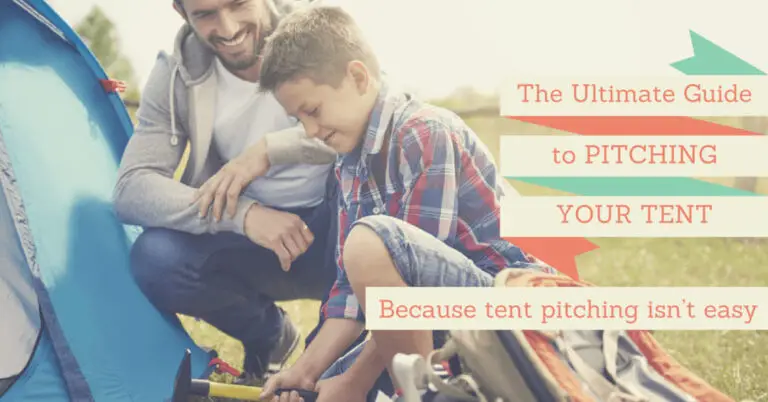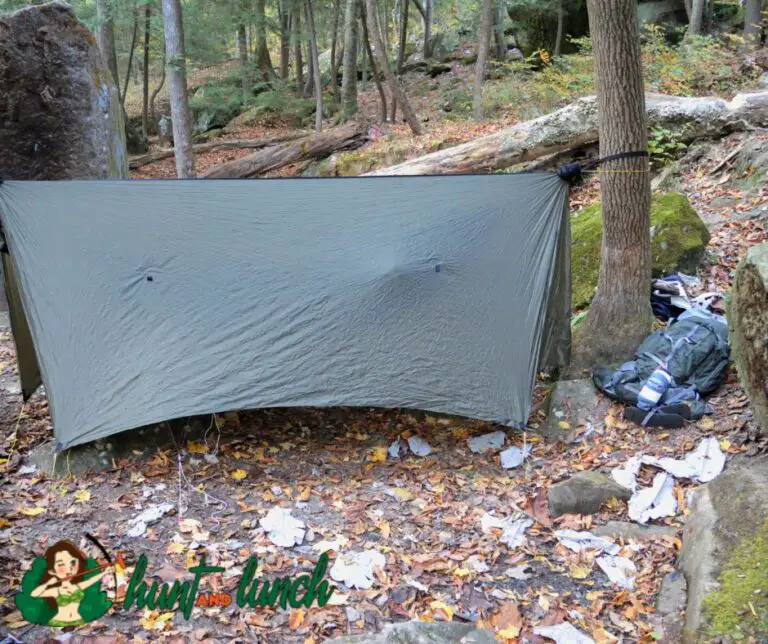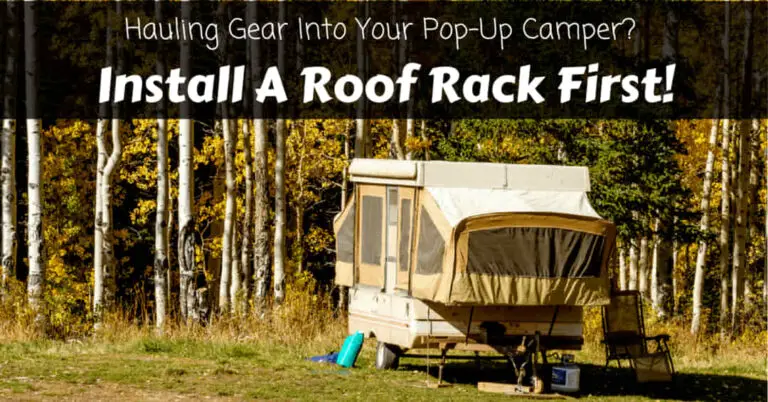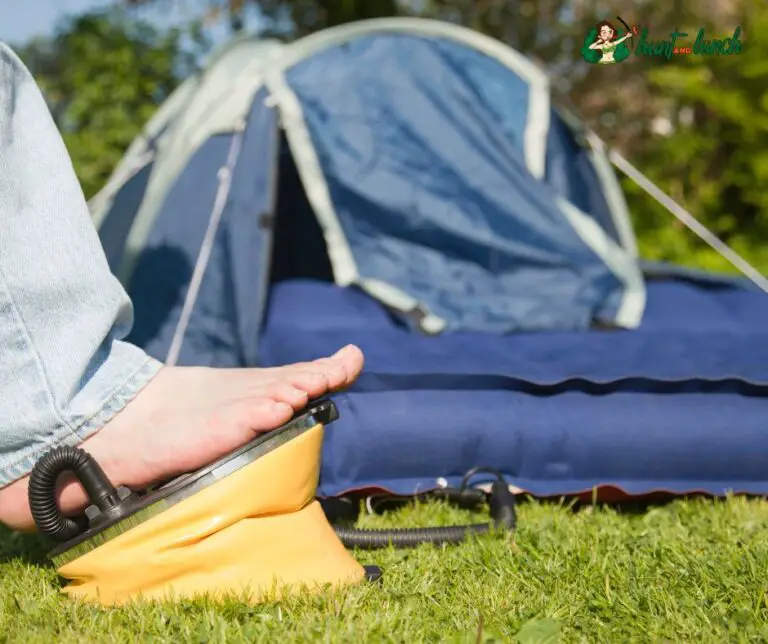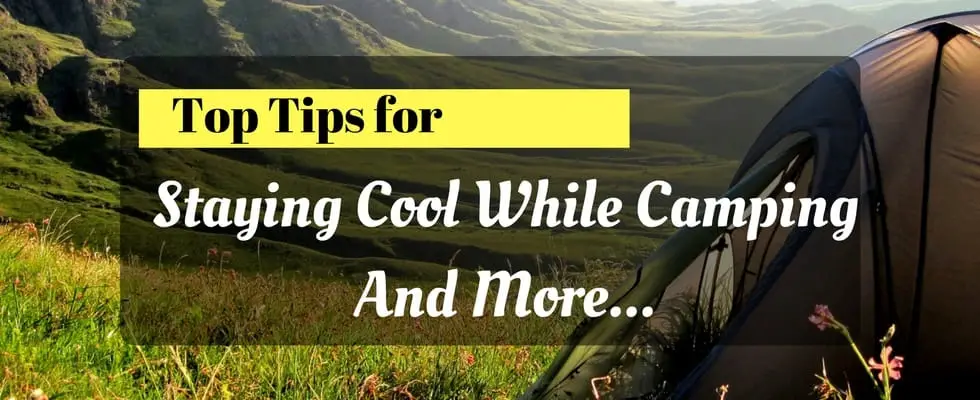
Being uncomfortably hot, rolling from one side to the other of the camping cot just to get a sleeping position with the most air, and sweating profusely every step of the way are some of the worst camping moments you’ll ever experience. If you’re at your wit’s end and you can’t think of solutions for staying cool while camping, don’t worry because we’ll lay out every single solution we have in mind for you.
Staying home when the sun is shining beautifully outside and the mountains look welcoming isn’t an option for campers like us. We naturally want to spend our days discovering nature instead of binge eating and watching on weekends.
But what are the things you can do to make the heat more bearable and less miserable? Surprisingly, there are tons. We’ll get to that later.
But first, you need to know what temperature is best and safe for camping, especially if you’re planning to bring your family along.
Tent Camping Temperature Chart

Above are the heat index values which may be substantially higher than outdoor readings. The temperature values indicate whether the outdoor temperature can be safe or tolerable by campers and non-campers alike.
Be sure to check the forecast weather data a day or a couple of days before the camping date.
If you’re a seasoned camper, perhaps you can manage yourself even in the hottest or coldest weather. But if you’re bringing your family along, be mindful of the kids and elderly. See if they are in good health and condition to brave the outdoors.
Top Tips For Staying CoolWhile Camping
1. Find the perfect camping spot
First, check the entire vicinity of the area where you’ll lay camp. Scout for the best spot guarded with trees for shading purposes.
Trees provide effective shading against the sun. It will keep your tent shades, as well as your food, things, and everything. If you’re camping in an area with sparse trees, save the limited shade for the tent as it heats up quickly.
It’ll also be helpful to bring a tent tarp. Hang the tarp from tree to tree and place your tent below for a greater shade. The tarp can also shield your tent from unexpected bursts of rain.
If possible, position your tent a few feet away from rivers and lakes to maximize the breeze brought by the swirling of waters. The only downside of camping near water bodies is the increase in humidity which may cause an increase the mosquitoes in your area.
2. Use camping fans
Camping fans are the portable and mostly battery-operated for ease of usage during camping or travelling. Perhaps, it’s the best way to keep yourself and your tent cool during hot afternoons when the air is very dry and still.
3. Wear light-colored clothing
Loose-fitting, light-colored clothes may be helpful in lessening the incoming radiation that produces heat in the body.
White and other light-colored clothes are light deflectors while black and deep-colored clothes are light absorbers.
When light is deflected, less heat penetrates into the body. Thus, opt for light-colored clothes when camping during summers and use dark ones during winter.
Another ingenious way of keeping cool when hiking is to wrap a wet bandana around your neck to keep your body temperature cooler under the scorching heat of the sun. This will make you feel more comfortable and cooler.
4. Schedule your activities
The simplest way to keep cool while camping is to seek campsites lying along lakes and rivers. This way, you can always take a dip after a long hike.
In reality, it’s not always the case. That’s why scheduling your activities as per the weather is important if you want to stay cool while camping during a hot weather.
If there’s no lake or river nearby to keep you feeling fresh, reserve strenuous activities during the morning or evening when the sun is low.
During the afternoons when the sun is low, seek out shelter in tents or caves. Cave touring is another wonderful activity provided that you have a guide.
5. Hydrate
Keeping the body hydrated is of utmost importance because water regulates the body temperature. When too much heat swells up inside our bodies, water forces them outside through perspiration.
Keep water and beverages in a cooler for a ready-to-go cold drink. Also, always bring a handy bottle whenever you’re going for short or long hikes.
- Here’s a tip: Freeze gallon jugs and store it in your cooler. They’ll keep food and beverages cold and you’ll also have cold water to drink for later.
A simple way of relieving your body of heat is to use a misting system such as an insulated spray bottle where you can keep cold water and spray them on your face to keep it refreshed. The feeling won’t last long but at least, you can spray all you want.
6. Sleep on a hammock
One of the best ways to keep your sweating at bay during hot afternoons is to sleep on a camping hammock.
In fact, there’s an ongoing debate comparing the versatility between camping hammocks and tents. Of course, our votes go to tents because it can shelter you through the harshest of rains.
But a camping hammock may be the better option during hot weather. Since it’s open and has no roofing unlike tents, air can circulate freely and sweat can evaporate much faster.
Keeping Cool In An RV
Camping in an RV may provide more comfort but it doesn’t exclude you from the heat of the sun.
Check out the short video clip below for some useful tips to keep your RV cool and comfortable.
Beat The Heat With These 3 Cool Camping Places
1. Natural Bridges National Monument, Utah
This monument features three gigantic steam-carved natural bridges, a nine-mile hiking loop road, and an enormous lake for the viewing pleasure of the whole family.
Be stunned at the remarkable rock formations at the bridges and go for the nine-mile hike before capping the day off with a relaxing boat ride in the lake. Your kids will definitely love to try some water activities allowed on the lake such as skiing, cliff diving, and wakeboarding.
They also have 13 campsites with tables and grills where you can rest your tired body when night falls.
2. Red River Gorge, Kentucky
The stunning gorge is situated within the Daniel Boone National Forest is a great place for activities such as rock climbing, kayaking, rafting, and hiking.
The canyon system is a camper’s paradise. Due to its rugged nature, there’s an abundance of natural bridges, waterfalls, sandstone cliffs, and rock shelters.
As a matter of fact, there are more than 100 natural sandstone arches in the area, making it a popular rock climbing destination.
3. Douthat State Park, Virginia
The Douthat State Park is one of the most family-friendly campgrounds we’ve ever been too.
The park has the most breathtaking mountain scenery and trails. They offer more than 43 miles of hiking and biking trails for seasoned and novice hikers and campers.
Stretched nearby is a 50-acre lake filled with trout, making it ideal for stream fishing. There are also boat rentals available and a sandy swimming beach for the kids.
You can also find 32 cabins in the park which can accommodate a maximum of 15 people.
We chose this as the venue for our family reunion last summer and we’re very happy with it. There are a lot of activities for the old and young. Also, it’s a very refreshing place – it will kind of remind you of your childhood days if you grew up on the countryside like me.
Read More: Heads Up Sleepers! The Better Choice: Hammocks vs. Tents
Final Thoughts
Don’t stay home and forget about that place you always wanted to explore just because the sun’s heat is very threatening.
Now that you enough knowledge of the essential things you should do in order to stay cool while camping, we trust that you can now brave the hot camping weather without bursting in a fit of hopelessness.
Try to visit the parks we’ve introduced to get the best of your kids’ summer vacation!
Hey, camper! Have you tried any of the tips we’ve listed in this post? Did it work for you? Do you have other suggestions? We’d love to hear your thoughts in the comments section below.
Did you find this article useful? If so, share it in your social media to show your appreciations. Cheers!

I’m Cindy, a free-spirited outdoor enthusiast. Since childhood, Our family frequently goes on weekend camps and my father, who was a skilled hunter, used to teach my siblings and me valuable things about wildlife survival. I made this blog to share my knowledge, experiences, and tips.


